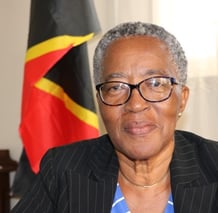
About Nevis
A Hidden Gem in the Caribbean Sea
Nevis is a small island located in the Caribbean Sea and is one of the two islands that make up the Federation of St. Kitts and Nevis.
Queen of the Caribbees
Nevis
Nevis was inhabited by the Amerindians specifically the Kalinagos as early as 100 BC naming the island 'Oualie' "Land of Beautiful Waters" and was later sighted by Christopher Columbus on his second voyage in 1945 and was said to name the island Saint Martin (San Martin).
However, because of the misunderstanding caused by several poorly-charted tiny islands in the Leeward Island group, this name was unintentionally moved to another island, which is still known as Saint-Martin. The island was renamed 'Nuestra Señora de las Nieves' "Our Lady of the Snows". First appeared on maps in the 16th century. Presumably the white clouds that usually cover the top of Nevis Peak reminded someone of this story of a miraculous snowfall in a hot climate.
Nevis was colonized through Saint Kitts in 1628 and Captain Anthony Hilton was appointed the first Governor of Nevis by Thomas Warner and named it Charles Town in honor of King Charles I of England.
Thus Saint Kitts and Nevis were the first English colonies in the Caribbean. The islands were transferred from the proprietary system to the protection of the English Crown in 1644 represented by the Governor General of the Leeward Island Isles. The island's name was change once more to 'Dulcina' "Sweet Island".
The current name Nevis was said to derived from the Spanish name Nuestra Señora de las Nieves by process of abbreviation and anglicisation.
Nevis became a major center for sugar cultivation in the 1680s, with the establishment of large-scale sugar plantations and the importation of enslaved Africans to work on the plantations. Because of its many plantations, the island was given the nickname "Queen of the Caribees".
The French captured Nevis in 1706 but returned to England in 1787 as part of the Treaty of Versailles, ending the conflict between England and France during the French Revolution. In 1869 Nevis, along with nearby St Kitts, became part of the British colonies as statehood consisted of St Christopher, Nevis and Anguilla. By 1958 Nevis joined the short-lived Commonwealth of the West Indies, a political entity of the British Caribbean colonies that existed until 1962. In 1980, Nevis gained self-government as part of the newly independent Saint Kitts and Nevis, becoming a sovereign state within the Commonwealth. However, in 1998 Nevis held a referendum on the independence of Saint Kitts and Nevis, but the vote fell short of the two-thirds majority necessary for secession.
Today, Nevis is a self-governing island within the Commonwealth of Saint Kitts and Nevis, with a growing tourism industry and efforts to protect its cultural heritage and natural environment.


Geography
Nevis is located in the Leeward Islands of the Caribbean, about 220 miles southeast of Puerto Rico and about 50 miles west of Antigua. It is located near the northern end of the Lesser Antilles. Nevis lies about 2 miles (3 km) southeast of Saint Kitts, across a shallow channel called "The Narrows". (Coordinates: 17 degrees 10' No., 62 degrees 35' W.)
Nevis covers an area of about 36 square miles (93 square kilometers). It is roughly circular in shape, with a diameter of about 7 miles (11 kilometers) and a circumference of about 20 miles (32 kilometers).
Dominated by a single peak, Mount Nevis, which rises to an elevation of 3,232 feet (985 meters). The island's terrain is generally hilly, with steep slopes leading down to the coast. There are several valleys and low-lying areas, including the fertile coastal plain in the west.
Nevis has a coastline that stretches for about 30 miles (48 kilometers). The island's beaches are generally small and secluded, with black volcanic sand and clear blue waters.
Nevis has a tropical climate, with temperatures averaging around 80 degrees Fahrenheit (27 degrees Celsius) year-round. The island receives about 55 inches (1,400 millimeters) of rainfall annually, with the rainy season typically occurring from May to November.


Constitution of St. Christopher and Nevis
The Constitution of Saint Kitts and Nevis was adopted on 23 June 1983 and took effect when the country became independent on 19 September 1983. It consists of 11 chapters and various schedules, which establish the rights, responsibilities and definition of the citizens of the federation. It also provides the form and structure of government, and enumerates the powers of the different branches of government. Its treatment of the island of Nevis is rather unusual among federated nations.
The current constitution of Saint Kitts and Nevis was prepared in anticipation of the country achieving independence from Britain. It is the only constitution the country has had as an independent nation, however there were several colonial constitutions before it. The union of the islands of Saint Kitts and Nevis has been controversial at least since 1882, leading the constitution to specifically provide for a path to independence for Nevis. This makes Saint Kitts and Nevis unusual among Federations.
The government created by the constitution is a constitutional monarchy headed by Elizabeth II, with a unicameral legislature. Nevis is provided with a separate island administration, but Saint Kitts is not.
Nevis
The constitution of Saint Kitts and Nevis is rather unusual in that it provides Nevis with a great deal of autonomy, and contains a provision allowing Nevis to secede should a two thirds majority of the island’s citizens vote for secession. In 1998 a referendum failed to achieve the required two thirds majority for independence.
Structure of Government
The constitution establishes Saint Kitts and Nevis as a federation consisting of two states, one on each island. However, Saint Kitts and Nevis differs from most federated states in that in a normal federation each state has its own regional government, with the federated government providing an overarching government. However, while the Constitution provides for Nevis to have its own separate legislature, Saint Kitts is governed directly by the National Assembly. Also, the constitution provides for the appointment of a Governor General for the whole of Saint Kitts and Nevis, who appoints a Deputy Governor of Nevis. So while Nevis has its own legislature, assembly, and island administration, Saint Kitts has no such independent legislative bodies and so it is not a typical federated government. The Constitution of Saint Kitts and Nevis is unique in that it creates a federation not between Saint Kitts and Nevis, but between Nevis and the federation of Saint Kitts and Nevis. It provides for the establishment of a unicameral legislature known as the National Assembly. The constitution directs that Saint Kitts and Nevis be divided into no fewer than 11 constituencies, at least 1/3 of which are in Nevis. The national assembly contains one representative from each constituency, together with at least three appointed senators.
The national assembly is empowered to make laws, but its ability to make laws impacting Nevis is restricted by Section 37 and Chapter X.
St. Kitts and Nevis Constitution
Nevis Island Administration
The Nevis Island Government is a democratic operation based on the Westminister Parliamentary system. The constitution that governs the federation was established in 1983 when the islands gained independence from the United Kingdom.
The Island of Nevis has it’s own unicameral legislature, consisting of the Deputy Governor General, the representative of Her Majesty, and members of the Nevis Island Administration.
The Nevis Island Administration has a Cabinet of Ministers consisting of a Premier, a Deputy Premier, other elected members and a maximum of two nominated members.








Members of Cabinet 2022-2027
Deputy Governor General
Her Honour Mrs. Hyleeta Liburd, M.H
Premier
The Honourable Mark Anthony Graham Brantley
Minister of Finance, Statistics, Economic Planning, Human Resources, Industry, Trade and Consumer Affairs, Tourism, Public Utilities and Energy, Foreign Investments, Government Information Service and Nevis Television
Deputy-Premier
The Honourable Eric Rohan Evelyn
Minister of Agriculture, Lands, Natural Resources, Fisheries, Cooperatives, Culture and Housing
The Honourable Spencer Rudolph Brand
Minister of Communications, Works, Water Services, Physical Planning and Environment, Posts, Labour and Disaster
Senators
Elected Members of The CCM Party
The Honourable U-Thant Troy Joval Tajeda Liburd
Senator with ministerial responsibility for Education, Information Technology, Library Services, Youth and Sports
The Honourable Mervil Jahnel Nisbett
Senator with ministerial responsibility for Health, Gender Affairs, Community Affairs and Social Empowerment
Oppostion
St. John's Constituency
St. Georges' Constituency
St. Paul's Constituency
Doctor Janice Daniel-Hodge
Leader of the NRP Party
Cleone Stapleton-Simmons
St. James' Constituency
St. Thomas' Constituency












Biodiversity
The Federation have a diverse range of ecosystems, including coastal areas, mangroves, tropical forests, and coral reefs. Here are some key aspects of the biodiversity profile:


The islands support a variety of plant species, including tropical vegetation such as palms, ferns, and a range of flowering plants. Some endemic plant species may be found on the islands, meaning they are unique to this region.
Flora
Fauna
St. Kitts and Nevis are home to a variety of bird species. Coastal areas and wetlands provide habitats for waterbirds. Marine life is diverse, and the surrounding waters support a variety of fish species, including those important for local fisheries; sea turtles, such as the Hawksbill and Green turtles, nest on the beaches.
The coral reefs around the islands are rich in marine biodiversity, hosting numerous species of fish, invertebrates, and other marine life. Mangroves play a crucial role in providing habitat for various marine species and serve as nurseries for many fish.
Marine Biodiversity
A Biodiversity Profile of Saint Kitts and Nevis
A Vegetation Classification of Saint Kitts and Nevis

Copyright ©2023 Arcquela Bendeito All rights reserved.







